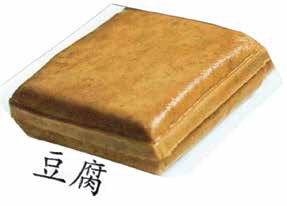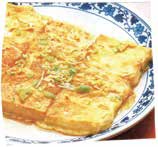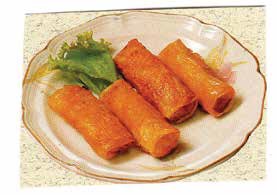
| What is Flavor and Fortune? |
| How do I subscribe? |
| How do I get past issues? |
| How do I advertise? |
| How do I contact the editor? |
Read 13071229 times
Connect me to:
| Home |
| Articles |
| Book reviews |
| Letters to the Editor |
| Newmans News and Notes |
| Recipes |
| Restaurant reviews |
| Article Index (all years, slow) |
| List of Article Years |
| Article Index (2025) |
| Article Index (last 2 years) |
| Things others say |
| Related Links |
| Log In... |
| Authors |
| Categories & Topics |
Doufu
| by Jacqueline M. Newman |
Vegetables and Vegetarian Foods
Summer Volume: 2019 Issue: 26(2) pages: 34 to 37
Used in many ways, the well-known popular dish, seen on the cover, in Chengdu and the entire Sichuan Province, even all of China, is mapo doufu. Made with coagulated bean curd, piquant peppers, and Sichuan peppercorns, when it is made without meat it is also popular among Chinese Buddhists and Chinese vegetarians, and other vegetarians.

The names of many dishes with doufu mimic those with animal foods. If they do, they can be named ‘imitation’ this or ‘imitation that’, or be called ‘vegetarian’ this or that. Many so named are mimics for dishes often made without the usual chicken, goose, spareribs, even pig’s feet. It can have titles that sound like a typical meat or fish or poultry dish but with none of that animal protein in them. Most are made with coagulated and pressed soy beans, themselves made from soy milk. The best ones press the curds a lot or a little and strain away the liquid pressed out.
These meat-substitute dishes can be titled, from very firm, use that mentioned coagulated soy bean milk and mimic whatever texture they desire. People who eat them know that their doufu is usually low in calories, high in protein, and a manmade product called ‘tofu’ in English. They can have lots of calcium or magnesium depending on the coagulant used to make them. A common one is calcium chloride, another can be magnesium sulfate, and there are others.
When we were first married and making our own doufu, I did make it with Epsom Salts as they are magnesium based. They were tasty, most had soft textures no matter how well I thought I was pressing or expelling as much liquid as I could. Years later, I learned this coagulant always made a somewhat soft doufu and it was not my ability to press out or not press out its water.
The word doufu literally means ‘bean’ and implies the soy is ‘curdled.’ That happens physically and some articles and folks write that it is ‘fermented soy curd’ but that is not so. It simply is just a physical change in the finished product. One can purchase fermented tofu; it is found in jars, with contents most often one-inch squares in a very salty or alcoholic liquid; and it is very good and if you know it not, buy and try it.
A coagulated product, fermented or not, was reported first in the US by Ben Franklin’s time. That was in 1770, and we know this because he wrote a letter to his friend James Flint about it. Before that, the Chinese did make and use it for more than two thousand years, and we know that its earliest use in China was from in the Han Dynasty when Prince Liu An (179 - 122 BCE) spoke about the technique and process. Knowledge about this food item spread from China to most of Asia. For the doubters, they need to know that a stone mural of making it was unearthed from an Eastern Han Dynasty tomb from those times and radio-carbon dated assuring it was known at least by then. Some believe the Chinese may have learned to make or name it from the Mongolians; they made a fermented milk they called rufu and they did coagulate it. Maybe doufu was modeled or named after their food We know it took many years to become popular, and that was during China’s Song Dynasty (960 - 1279 CE) when it did.
Doufu spoils quickly in warm weather, and it was an honorific offering when people visited the graves of their deceased relatives. Doing so or not, many love it use it often, perhaps in an omelet or a dish with green vegetables. The recipes that follow were popular then and still are. Some people carry one or more of these dishes to the cemetery on a day honoring a deceased relative; and they can eat it picnic-style there sharing it with their loved ones who already passed on.
Most recipes in this article, and some in the article about ducks, geese, swans in other issues have no meat in them. Buddhists love them and are the ones who might take them when they visit where they find their tombstones, others might place them before the places in their homes where they honor them. Many of these dishes have the name of a meat in their title but the ingredients used to make them omit that item.
There are many cookbooks with hundreds of such preparations available for those wanting to do so. These dishes can be brought to the cemetery for that purpose. Visit your local library to see if they have such a book so you can make one of those recipes or the ones included in this issue, or an earlier one.

| Bean Curd Omlet |
|---|
1 Tablespoon vegetable oil
1. Heat oil in a wok or fry pan, add the mushroom pieces
and the sesame seeds, and stir-fry for two minutes until
they are lightly colored.
|
| Jade Mushrooms |
|---|
1/4 cup vegetable oil
1. Cut away the mushroom stems and save them for
another use
|

| Imitation Chicken Rolls |
|---|
1 large sheet dried bean curd, cut into five-inch squares
1. Dry-fry shredded mushrooms mixed with the needle
mushrooms, shredded bamboo shoots and shredded
pineapple, then roll some of this mixture into one bean
curd sheet.
|
| Soy Sprouts with Fennel |
|---|
5 slices fresh ginger
1. Smash ginger and blanch in boiling water one minute,
then put in cold water half minute and drain well.
|
| Doufu as Pigs Feet |
|---|
1 purchased or home-made flour-dough sausage
1. Cut the sausage into four-inch pieces and deep fry
them in hot oil until they turn light tan, then drain them
on paper towels.
|
| Doufu with Garland Chryanthemums |
|---|
1 pound garland chrysanthemums, each cut across half-inch lengths, blanched one minute, then rinsed with cold water and drained
1. Mix chrysanthemum and doufu with the sesame oil,
salt, and sugar.
|
| An Eatery's Mapo Doufu |
|---|
1 Tablespoon vegetable oil
1. Heat wok or fry-pan, add oil, and cook scallion pieces,
pork, and the garlic, stir-frying for one minute.
|

Copyright © 1994-2025 by ISACC, all rights reserved
Address
3 Jefferson Ferry Drive
S. Setauket NY 11720